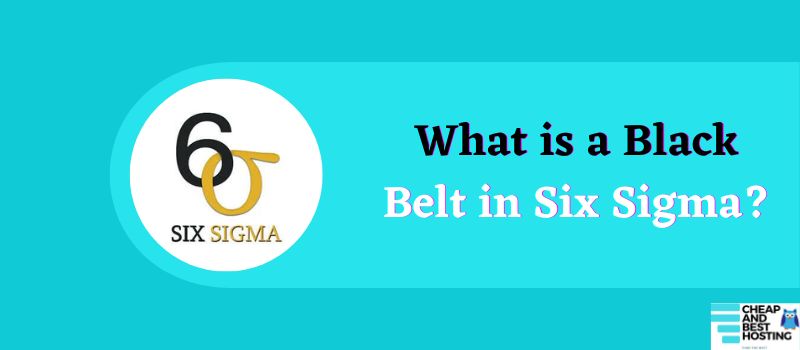A very efficient approach to controlling extensive and complicated operations inside enterprises and organizations is the Six Sigma methodology. Employers of the Six Sigma technique frequently pursue higher certification levels, beginning at the white belt level and on to the black belt and master black belt levels. A significant accomplishment that may highlight your advanced knowledge and abilities is becoming a black belt in Six Sigma.

Six Sigma favors quantitative rather than qualitative success indicators. Employees that use analytics, financial statement analysis, and product development and management to improve company functioning are most involved with Six Sigma.
What Does a Six Sigma Black Belt Entail?
A professional’s advanced understanding of the conceptual Six Sigma project management approach. It emphasizes data and statistics to monitor the efficacy, productivity, and success of processes in an organization, which is represented by a black belt certification in Six Sigma. The Six Sigma system is widely used by businesses to enhance project management, business analysis, and general functionality.
Six Sigma techniques are frequently used by experts in IT, statistics, and analysis. It is to assess corporate effectiveness using quantitative rather than qualitative measurements. Having a black belt in Six Sigma shows that you have a deeper understanding of the applications of the system.
Advantages of Acquiring a Black Belt in Six Sigma
Getting your black belt may offer a lot of benefits. The intricacy of the Six Sigma methodology and its implementations means that each level you reach may attest to your capacity to continually learn new abilities and put those abilities to use. Additionally, the black belt certification, which is one degree below the highest possible level of Six Sigma proficiency, may demonstrate to potential employers your drive to take on leadership responsibilities and enhance your performance.
Consider a few more advantages of becoming a Six Sigma black belt:
- Job prospects are increased: Individuals with advanced credentials, like the Six Sigma black belt, may frequently broaden their job prospects to senior and upper-management positions as well as be eligible for higher-level promotions.
- Increases potential earnings: Six Sigma Black Belt professionals frequently make more money than white, yellow, and green belt professionals.
- Supports the development of leadership: The black belt certification trains professionals to lead teams in the use of Six Sigma’s principles, techniques, and tools.
- increases proficiency with tools and processes: The complicated issues covered in the Lean Six Sigma Black Belt certification program expand on those covered in the earlier levels.
How to Become a Six Sigma Black Belt?
You can complete the processes listed below to obtain your black belt assuming you have achieved the prior Six Sigma certification levels:
1. Complete the Requirements For Obtaining a Black Belt.
Six Sigma black belt training from a corporate program, Six Sigma trainer, or certified school might help you get ready for your exam even though it is not required. The training curriculum typically builds on ideas learned at the green belt level and covers advanced applications of DMAIC (define, measure, analyze, improve, and control) techniques, venture integration, project management, development and organizational management, data analysis, and financial and performance measures.
2. Finish and Turn In the Requirements For Your Six Sigma Project.
The majority of testing venues and certifying organizations demand that you finish and produce a project while utilizing the proper Six Sigma methods and instruments. A Six Sigma project frequently uses performance improvement models that correspond to actual performance and productivity metrics to restructure and enhance procedures in the manufacturing and service sectors. Activities in product quality evaluation, human resources, industrial processes, and financial activities can all be covered by Six Sigma programs.
3. Pass Your Certification Examination.
Every tier of Six Sigma certification, along with the black belt level, is available through the International Association for Six Sigma Certification (IASSC). You may choose to take practice exams to assess your aptitude before taking the real exam, based on the certified organization you take your test via. Be careful to verify with the institution so you are aware of the precise test criteria you must satisfy. Many organizations also conduct the qualifying examination as an open-book examination.
4. Fill Out an Application to Get Your Black Belt
You get to be a Certified Six Sigma Black Belt™ after passing your exam (CSSBB). This certification might help you become ready to enhance your expertise to the master level by demonstrating your advanced understanding of Six Sigma-compliant project management and analytic procedures. You can benefit from leadership training, mentorship opportunities, and advanced training after earning your black belt certification to further your proficiency in Six Sigma applications.
5. Make Career Advancements
A notable achievement that many Six Sigma specialists frequently desire is becoming a Six Sigma master black belt. You can finish master’s black belt training to reach the maximum degree of proficiency once you have more experience working with apps at the black belt level on the job. Your professional possibilities, earning potential, and chances for development can all be significantly improved with a master’s black belt degree.
Highlights of Six Sigma Black Belt Training
● With Live, Instructor-Led Sessions, Acquire 36 PDUs
● Projects, Case Studies, 5 Simulation Exams, and 200+ Quizzes
● Activities-Packed Interactive Sessions
● Case Studies, real-world simulations, and more
● experts in quality management who are trainers
● 180-Day Grand Pass provides access to all classes.
A Lean Six Sigma Black Belt™ – Roles in an Organization
Six Sigma Lean Change agents are another name for black belts. They are full-time project managers who use the Lean Six Sigma methodology. You may set up your lean six sigma principles in a variety of ways. DMAIC (Define Measure, Analyze and Improve, Control) and DFSS Design for Six Sigma (DFSS) (Also known as DMADV) are two approaches used. Six Sigma Lean Black Belts are experts in Lean Six Sigma techniques and methodologies. Additionally, they oversee and support change. Customer happiness and corporate productivity are both enhanced as a result.
The “Lean Six Sigma” Black Belts often complete a more advanced level of Lean Six Sigma training and show their proficiency by finishing a project with a black belt designation. Coaching Green Belts is done by Black Belts and Master Black Belts. A Black Belt is anticipated to be elevated to a Master Black Belt after the Black Belt mission is finished.
Conclusion
You will be a complicated project manager, a catalyst for change, a professor, an advisor, a successful businessman, and a Six Sigma Black Belt. They are looked after by several businesses due to the desirable traits they have, such as their drive for finding solutions to challenging challenges. Black Belts are a clear choice for leadership positions in a business because of their emphasis on improving management and productivity enhancement.
Latest Post
- Top 10 Best ARK Server Hosting for Gamers [Servers For ARK Survival Evolved]
- HTTP 302 Status Code: Meaning, Causes and Solutions
- Top 10 Best Valheim Server Hosting | Valheim Dedicated Server for 2024
- 240 Minecraft World Names | The Best Name Ideas For Your World
- Palworld Server Hosting | The Best 5 Hosting Providers For Palworld
- Semrush Coupon Code 2024: Get 17% OFF Deal
- 6 Best VPS for Gaming in 2024
- Best Black Friday Deals of 2024
- Quillbot Black Friday Deals 2024: Try A Better Product
- Contabo Black Friday 2023 Deals: Don’t Miss Out on Exclusive Discounts!
